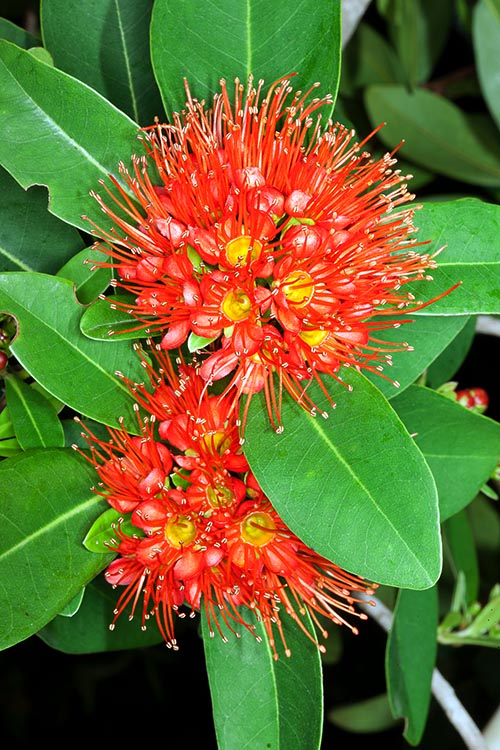Family : Myrtaceae

Text © Pietro Puccio

English translation by Mario Beltramini

At home in New Caledonia, Purpureostemon ciliatus is still little cultivated in Europe despite the undoubted horticultural potential © Giuseppe Mazza
The name of the genus is the combination of the Latin adjective “purpureus, a, um” = purplish, and of the Greek substantive “στήμων” (stemon) = stamen, with obvious reference; the name of the species is the Latin adjective “ciliatus, a, um” = with cilia, with reference to the young leaves ciliated at the base.
The Purpureostemon ciliatus (J.R.Forst. & G.Forst.) Gugerli (1939) is a much ramified, erect or prostrate shrub, evergreen, 0,6-2 m tall, with villous young branches.
The leaves are simple, alternate the lower ones, almost opposite the upper ones, sub-sessile, oblong to elliptic with obtuse apex and curved margin, coriaceous, thick, rigid, densely villous and ciliated at the base when young, 2,5-3,5 cm long and 0,5-1,5 cm broad, of bright pale green colour on the upper page, pale green below.
Terminal inflorescences, on short peduncle, formed by corymbiform cymes carrying red flowers with villous calyx having 5 free triangular sepals, 5 ovate, villous, ciliated petals and about 25 long erect stamina.
The fruits are trilobed capsules of bright red colour when ripe, of 1-1,2 cm of diameter and 0,6 cm of height, containing numerous oblong seeds.
It propagates by seed in sandy loam maintained humid at the temperature of 20-22 °C and by cutting.
Practically unknown species in cultivation, but of remarkable ornamental value, cultivable in full sun in the tropical, subtropical and marginally warm temperate climate zones, on draining, even poor, soils; well rooted it can bear periods of dryness.
Potentially is an excellent subject for the cultivation in pot, due to the reduced size, the compact and elegant foliage and the bright red inflorescences.
Synonyms: Leptospermum ciliatum J.R.Forst. & G.Forst. (1775); Melaleuca ciliata (J.R.Forst. & G.Forst.) G.Forst. (1786); Metrosideros ciliata (J.R.Forst. & G.Forst.) Sm. (1797); Metrosideros buxifolia Dum.Cours. (1811); Stenospermum ciliatum (J.R.Forst. & G.Forst.) Heynh. (1841); Fremya ciliata (J.R.Forst. & G.Forst.) Brongn. & Gris (1863); Nania ciliata (J.R.Forst. & G.Forst.) Kuntze (1891); Xanthostemon ciliatum (J.R.Forst. & G.Forst.) Nied. (1893).
→ To appreciate the biodiversity within MYRTACEAE family please click here.
